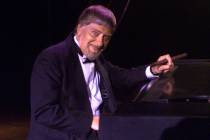Philharmonic adds some pop to Chaplin’s classic ‘City Lights’
The first presentation of the Las Vegas Philharmonic's Pops season was, shall we say, "interesting."
Charlie Chaplin's black-and-white silent (almost) film "City Lights" was shown in its entirety on Reynolds Hall's immense drop-down screen, with background music provided by the orchestra onstage.
Unusual? Yes, in this day and age, but "City Lights" was released in 1931 and was Chaplin's version of a crossover product: a film he hoped would bridge the gap between silent films and talkies.
The first feature-length talking film, "The Jazz Singer" starring Al Jolson, had appeared four years earlier in 1927.
"City Lights" was not strictly a silent film. It had a soundtrack with a few sound effects and a background score whose reproduction was limited to the squawky recording devices available at the time.
I've heard the original. A live orchestra makes an immeasurable difference.
The score's composition is credited to Chaplin collaborating with Arthur Johnson.
Chaplin, who did not write music, la la'd tunes to Johnson who fleshed them out. Later came Bernard Hermann ("Citizen Kane," " Vertigo," "Psycho," and dozens of other great scores) who gave them the full treatment for orchestra.
Guest conductor for this concert was Taras Krysa, one of nine candidates to fill the vacant post of music director for the Philharmonic. He and eight others will each conduct one of the orchestra's five Masterworks concerts and four Pops concerts this season.
Krysa was severely limited in what he could do in terms of expressiveness and tempo selection since everything had to synchronize precisely with the action on screen. In the face of such limitations, Krysa did a workmanlike job.
Even though rehearsal time is at a premium for the Pops series, the orchestra was well prepared and at times its sound was lush and radiant.
The music's thematic material cannot be fully credited to Chaplin. In fact, the motif that accompanies the ingénue, a blind flower girl, is "borrowed," note for note, from a popular tune of the day, "La Violetera," ("Won't You Buy My Violets") by Jose Padilla.
Chaplin was sued for failing to give credit to Padilla. Chaplin lost.
Several other familiar tunes appear; "Swanee River" and "How Dry I Am" among them.
The score's style is eclectic, ranging from a quite light and lovely Straussian waltz to somber echoes of another Strauss, Richard, and hints of many others from Wagner to Gershwin.
The score emphasizes contrasts as does the film; wealth and poverty, humor and sadness, exhilaration and depression.
Such contrasts are hallmarks of most Chaplin films, but perhaps not to the extent found in "City Lights" which has been hailed as his masterpiece.
Charlie Chaplin's career spanned six decades beginning with his arrival in Hollywood in 1914 to his last film, "A Countess From Hong Kong," in 1965.
In all, he made 82 films with composer credit in 13 of them. Among them were "The Great Dictator," "The Kid" and "Limelight." Chaplin's most endearing character by far was The Little Tramp, who appears in many of his silent films and is the focus of "City Lights."
Had "City Lights" been a less captivating film, the audience might have paid a bit more attention to the orchestra. But Chaplin's relentless slapstick and sight gags, punctuated by some truly poignant moments, demand full visual application.
As is the case with most film scores, the music plays second fiddle (pun intended) to the screen, and that's the way it should be.
REVIEW
WHO: Las Vegas Philharmonic Orchestra
WHEN: Saturday
WHERE: Reynolds Hall at The Smith Center for the Performing Arts
GRADE: B+























